#thank you guys so much!
Text
A Recipe for Daropaka and a Korithian Meal

Hello everyone! (More than) A few days ago I said that, as a way to celebrate reaching 200 followers that I would make one of the dishes from the setting of my WIP. I did something similar for 100 followers which you can see here. This time around I put up a poll to see what dish you all would like to see based on the favorite dishes of my OCs. You voted for Otilia's favorite food, a cheesecake (Daropaka) from the land of Korithia.
However because I felt a bit bad about how long it took me to get to this and because I needed to make something for dinner anyway, I prepared an entire Korithian meal, specifically the last dinner Otilia ate before she left her homeland.
I will give a short description and some history for each component of the meal and will also provide recipes. These recipes come specifically from the Korithian city-state of Kalmanati.
BIG POST ALERT

The diet of Korithians is highly reliant on cereals, grapes, and olives. Barley is the most commonly consumed cereal and is used in the bread of most commoners. However, Kalmanati is famed for the quality of its wheat, and particularly among the wealthy, wheat is the cereal grain of choice. Legumes (Lentils, peas, vetch, beans, etc), vegetables (Cabbage, carrots, lettuce, seaweeds, artichokes, asparagus, onions, garlic, cucumber, beets, parsnips, etc.) and fruits/nuts (pomegranate, almond, fig, pear, plum, apple, dates, chestnuts, beechnuts, walnuts, rilogabo(Kishite regalu "Sunfruit"), bokigabo (Kishite botagalu "Northern fruit), etc.) also make up a significant portion of the Korithian diet, with meat (Cattle, lamb, pig, goat, goose, duck, horned-rabbit, game) and fish typically filling a relatively minor role except for in the diets of wealthy individuals (like Otilia).
Vinegar, oil, and garlic appear in almost all Korithian dishes and are an essential aspect of the Korithian palate.
Recipes below the cut!
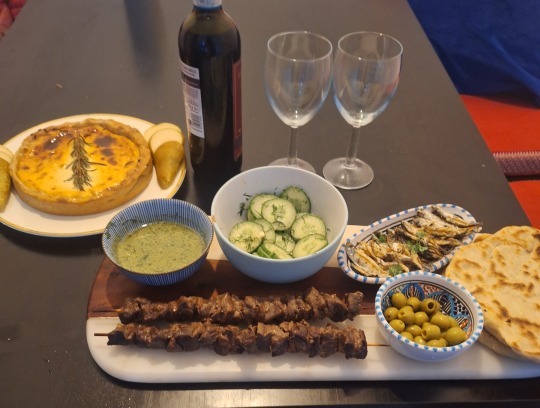
The components of the meal are as follows:
Daropaka: (Korithian: Daro = cheese, paka = cake)
Karunbarono: (Korithian: Karun = meat, baro = fire (barono = roasted) )
Pasrosi Diki: (Korithian: Pasrosi = fish(es), Diki = small)
Psampisa : (Korithian: Psamsa = bread, episa = flat)
Akuraros : (Korithian: Akuraros = cucumber)
Ewisasi : (Korithian: Ewisasi = olives)
Funemikiwados: (Korithian: Funemiki = hill (mountain diminutive), wados = oil/sauce)
Wumos: (Korithian: Wumos = wine)
Daropaka aka Awaxpaka aka Korithian Cheesecake
Daropaka is a popular dessert in Korithia, however its origins predate Korithia by several thousand years.
The dish originates from a race of forestfolk living on the Minosa, known as the Awaxi. The Awaxi were a tall and powerful race, some rivaling even demigods in size. Aside from their size the Awaxi were also easily identifiable by the third eye which sat on their forehead and the porcupine like quills which grew from their shoulders, sometimes called the Awaxi mantle.
The Awaxi were a primarily pastoralist civilization, living in small semi-temporary communities where they raised cattle and goats. They are credited with inventing cheese.
The first humans that the Awaxi came into contact with were the Arkodians. The Arkodians introduced the Awaxi to metallurgy, and in exchange the Arkodians were given knowledge of the cheesemaking process. This early form of cheese was called darawa (Korithian: Daro) and was typically made from cow's milk and vinegar, the resulting cheese being soft and crumbly, similar to a ricotta.
Unfortunately peace would not last. The Awaxi settled disagreements and debates often through duels, rather than through war. While quite skilled duelists, their culture had no reference for strategy in battle and lacked the proper skills to fend off the organized assault from imperialistic Arkodians. The Awaxi were eventually driven to extinction, though they still appear as monsters in Korithian myth.
The Arkodians themselves would later fall, destroyed by the Kishites, however many of their recipes, including their recipe for cheesecake, would be passed down to their descendants, the Korithians.
Recipe
(Note that Korithia has no distinct set of measurements nor are recipes recorded. Recipes are typically passed down orally and differ greatly between regions and even families. Adjust ingredients to one's own liking) (Also note that this is not like a modern cheesecake, as it utilizes a ricotta like cheese the texture will not be as smooth and it doesn't use eggs as chickens have not yet been introduced to Korithia)
The Cheese
1/2 Gallon of Whole Cow or Goats Milk
1 Pinch of Sea Salt
2 Bay leaves
2 Tablespoons of White Vinegar
1 Large Ripe Pear
6 Tablespoons Honey
2 Tablespoons White Wheat Flour
1 Tablespoon Rilogabo Juice (substitute 1:1 Orange and Lemon juice)
The Crust
1 Cup White Wheat flour
Water, Warm
1 Pinch of Sea salt
The Topping
1 Sprig Rosemary
3 tablespoon honey
2 tablespoon rilogabo juice (see above)
1 Large pear (optional)
Fill a pot with milk. Stir in salt and add bay leaves. Heat over medium heat until milk registers around 190 F, do not allow to boil. Look for slight foaming on the surface, when the temperature has been reached, remove the bay leaves and add vinegar, the curds will begin to form immediately, stir to fully incorporate vinegar without breaking curds. Stop.
Take the pot off of the heat and cover, allow it to sit for 15 minutes.
Using cheesecloth, a fine mesh strainer or both, separate the curds from the whey. Allow the curds to cool and drain off excess liquid.
Preheat the oven to 410 F or 210 C. Grease the bottom and sides of an 8 inch cake pan with olive oil.
While cheese is draining, make the crust. Knead the white wheat flour with a pinch of salt and warm water for about 15-20 minutes, until obtaining a smooth consistency. Roll a thin circular sheet larger than the cake pan. Lay the dough inside, trim off any dough which hangs over the edge of the pan.
Skin and seed 1 large pear, using either a mortar and pestle or a food processor, break the pear down into a paste or puree, there should be no large visible chunks.
Combine drained cheese, 6 tbsp honey, pear puree, flour, and rilogabo juice. Using a food processor or other implement combine ingredients until a smooth texture is achieved. Taste and add honey accordingly
Pour the mixture into the pan, careful not to exceed the height of the crust. Top with a sprig of rosemary and place into the oven.
Cook for 25-30 minutes or until the filling has set and the surface is golden.
Make the topping by combining 3 tablespoons of honey and the remaining rilogabo juice.
Remove cake from the oven and pour the topping over the surface. Allow the cake to cool
Serve warm, cold, or room temperature with fresh fruit.
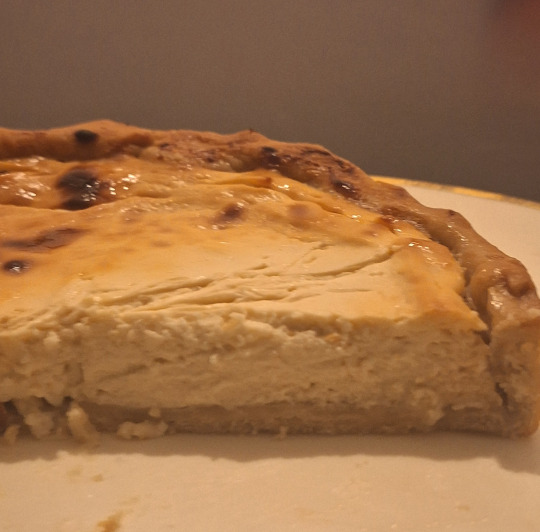
Karunbarono aka Roasted Meat
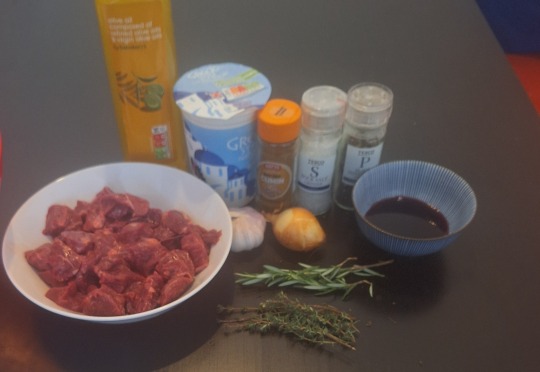
Cooking meat on skewers is a staple of Korithian cuisine, so much so that in certain regions the metal skewers or kartorosi, can be used as a form of currency. Meat is typically cooked over an open fire or on portable terracotta grills, though it is not unheard of to use a large beehive shaped oven or baros. The majority of the meat eaten by the lower classes comes in the form of small game such as rabbit or sausages made from the scraps of pork, beef, mutton, poultry, and even seafood left after the processing of more high-class cuts. The chicken has not yet been properly introduced to the islands, though some descendants of pre-Calamity chickens do exist, though they in most cases have drastically changed because of wild magic. Animals are rarely eaten young, lambs for example are almost never eaten as their potential for producing wool is too valuable. Most animals are allowed to age well past adulthood, except for in special circumstances. The practice of cooking meat in this style is prehistoric stretching back far before Korithia or Arkodai. What is newer however is the practice or marinading the meat before cooking it, this is a Korithian and later Kishite innovation.
Recipe
1 lb Mutton (meat used in this recipe), beef, lamb, venison, or horned-rabbit meat (in order to achieve this it is suggested to use wild hare meat in combination with pork fatback) chopped into bite sized pieces
4 Tablespoons Plain Greek Yogurt
4 Tablespoons Dry Red wine (Any dry red will work, for this recipe I used a Montepulciano d'abruzzo but an Agiorgitiko would work perfectly for this)
3 Tablespoons Olive Oil
4 Cloves of Garlic roughly chopped
1 Small onion roughly chopped
1 sprig fresh thyme
1 sprig fresh rosemary
1 tsp sea salt
1 tsp black pepper
1/2 tsp ground cumin
Gather and measure ingredients
Combine everything into a large bowl and stir, making sure that all pieces of meat are covered in the marinade.
Cover and allow meat to sit, preferably in the fridge for 2 hours or up to overnight.
Well the meat is marinating, if using wooden or bamboo skewers, soak in water for at least one hour to prevent burning.
Preheat the oven to 400 F or roughly 205 C. Or if cooking an open fire, allow an even coal bed to form.
Remove meat from the fridge, clean off excess marinade including any chunks of garlic or onion
Place meat tightly onto the skewers making sure that each piece is secure and will not fall off.
Brush each skewer with olive oil and additional salt and pepper to taste, optionally add a drizzle of red wine vinegar.
Place on a grate either in the oven with a pan below it to catch drippings or else over the fire. Allow to cook for 10-20 minutes depending on how well you want your meat cooked (less if using an open fire) Check every five minutes, flipping the meat after each check.
Remove from the oven and serve immediately.
Pasrosi Diki aka Little Fishes

Despite living by the sea, fish makes up a surprisingly small part of most Korithians' diet. The most valuable fish typically live far away from shore, where storms and sea monsters are a serious threat to ships. Much of the fish that is eaten are from smaller shallow water species, freshwater species, or shellfish. Tuna, swordfish, sturgeon, and ray are considered delicacies, typically reserved for the wealthy. Marine mammals such as porpoise are eaten on rare occasions, typically for ceremonial events. Pike, catfish, eel, sprats, sardines, mullet, squid, octopus, oysters, clams, and crabs are all consumed by the poorer classes. Sprats and sardines are by far the most well represented fish in the Korithian diet, typically fried or salted, or even ground and used in sauces. This particular recipe makes use of sprats. Unlike their neighbors in Baalkes and Ikopesh, Korithians rarely eat their fish raw with the exception of oysters.
Recipe
(Note that unlike modern recipes using whitebait, these are not breaded or battered as this particular cooking art has not yet been adopted in Korithia, though it is in its infancy in parts of Kishetal)
10-15 Sprats (other small fish or "whitebait" can also be used)
2 quarts of olive oil (not extra virgin)
Sea salt to taste
Black Pepper to Taste
Red Wine Vinegar to taste
Gather ingredients
Inspect fish, look for fish with clear eyes and with an inoffensive smell, avoid overly smelly or damaged fish.
Pour olive oil into a cast iron skillet or other high sided cooking vessel and heat to approximately 350 F or 177 C.
Fry the fish in batches of 5, stirring regularly to keep them from sticking. Cook for 2-4 minutes until the fish have started to crisp. Be careful, some fish may pop and spit.
Remove fish from the oil and allow them to drain.
Season fish with salt, pepper, and vinegar and serve.
Psampisa aka Flatbread
There are many varieties of bread eaten in Korithia and grain products make up anywhere from 50 to 80 percent of an average individuals diet. This particular variety of bread is most popular in the southern and eastern portions of Korithia, whereas a fluffier yeasted loaves are more commonly eaten in the west and north. This recipe is specifically made with wheat but similar breads can also be made with barley or with mixtures. If you do not want to make this bread yourself it can be substituted with most pita breads. Bread is served with every meal and some meals may feature multiple varieties of bread.
(Note for this recipe I only had self-raising flour at hand which gives a slightly puffier bread, if this is what you want add roughly 3 tsps baking powder)
Recipe
2 1/2 cups white wheat flour plus more for surface
1 1/2 teaspoons sea salt
1 cup whole fat greek yogurt
Olive oil for cooking
In a large bowl, mix together the flour, salt and baking powder. Add the yogurt and combine using a wooden spoon or hands until well incorporated
Transfer the dough to a lightly floured surface and knead by hand for 5 minutes until the dough feels smooth.
Cover the dough and allow to sit for approximately 20 minutes
Separate dough into desired number of flatbreads.
Add flour to each dough ball with your hands and then use a rolling pin to flatten out the dough on a lightly floured surface. Size is up to taste.
Heat a pan on medium high heat. Add the olive oil and cook the flatbreads one at a time for about 2-4 minutes, depending on thickness, per side until the bread is puffed and parts of it has become golden brown.
Akuraros aka Cucumber (Salad)

While the cucumber has become a relatively popular crop within Korithian agriculture it is not native and was all but unknown to their Arkodian predecessors. Cucumbers, which actually originated in Sinria and Ukar, were introduced by Kishite invaders during the Arko-Kishite war and were subsequently adopted by the survivors of that conflict. Cucumbers are associated with health and in particular with fertility. Cucumbers are typically eaten raw or pickled. They may be used in salads or even in drinks, ground into medicinal juices. Cucumbers are additionally believed to ward off disease carrying spirits and may be hung outside of the doors of sick individuals to ward off evil entities. Cucumbers are also fed to learning sages, as they are believed to strengthen the resolve and spirit. A potion consisting of the magical herbs wumopalo and lisapalo, wine, and cucumber juice has historically been used to temporarily induce in non-sages the ability to see spirits. Dill is additionally believed to produce positive effects, thought to ward of diseases of the stomach and cancers. Dill is often used in potions which may effect the physical nature of an individual, these potions are rarely used as their effects are most often permanent to some extent.
This particular cucumber salad recipe is a favorite in the region around Kalmanati, Bokith.
Recipe
1 large cucumber cleaned
2 cloves garlic roughly chopped
2 tablespoons fresh dill chopped
1/3 cup red wine vinegar
1/4 cup extra virgin olive oil
Salt to taste
Pepper to taste
Cumin to taste
Cut cucumber into thin slices (the actual width will vary dependent on taste)
Combine cucumber and all other ingredients in a non-reactive container and mix.
Cover and store the salad for at least 30 minutes and up to 12 hours.
Serve cold
Ewisasi aka Olives

The Ewasi or olive is in many ways the center of Korithian cuisine, as it is also in Baalkes and Knosh. Olive oil is used regularly and the olive fruit is consumed at all meals of the day including dessert. Olives are cured via the use of water, vinegar, brines, or dry salt in order to remove their innate bitterness. There are hundreds of varieties of olive in Korithia alone, their taste dependent on when they are harvested, how they are cured, the particular cultivar, and even the soil in which they are grown. Kalmanati is best known for two varities of olive, the kalmi, which is red fleshed and meaty, typically cured in red wine vinegar, and the prasiki, a small green olive which is firm and slightly nutty in flavor.
Recipe
Take your favorite olives, put them in a bowl. Optionally add vinegar and herbs
Funemikiwados aka Hill Sauce
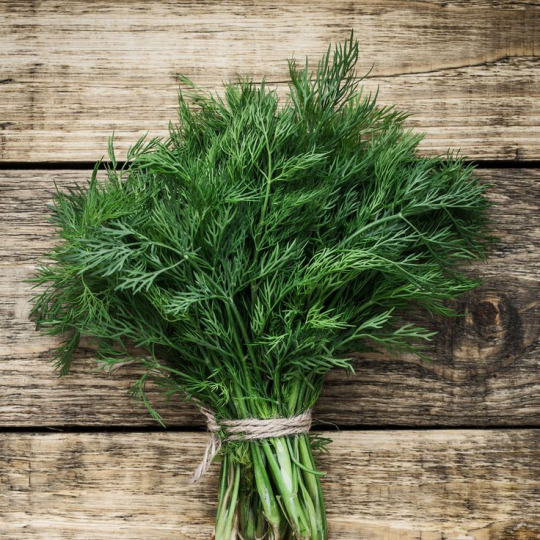
Hill sauce is the condiment of choice for most Korithian households and the exact nature of the sauce will vary greatly from region to region. In the north it is most often composed of pine nuts, olive oil, onion, vinegar, salt, and garlic. In the south the sauce is typically far more marine in nature, composed of seaweed, fish, garlic, olive oil, and vinegar. In all cases the ingredients are combined and mashed or ground to produce a pourable/dipable sauce. The sauce itself originates from the center of Korithia around the city of Bokakolis. The sauce was originally used by shepherds to flavor dried meats which may otherwise be dry or flavorless. Its name derives from the ingredients used within these early versions of the sauce, many of which were herbs plucked from the hillside while the shepherds tended to their flocks. The Kalmanatian version of the sauce is similar to this original herb based variety however it adds salt-cured fish and tisparos (Tisi - tickle, paros- seed) , another Kishite import (there it is called lisiki). This sauce is often used with practically any savory food, poured on meat, fish, vegetables, and bread. Often a house may be judged by the quality of their funemikiwados. Among the Kalmanatians there is two varieties of the sauce, a fresh version (the one described here) and another which is typically made with dried herbs and has additional vinegar added to act as a sort of preservative.
Recipe
1/2 cup extra virgin olive oil
1/3 cup red wine vinegar
2 tbsps rilogabo juice (1:1 orange and lemon)
2 anchovies (or other small salt-cured fish)
1/4 cup fresh chopped dill
1/6 cup fresh chopped parsley
1/8 cup fresh chopped thyme
6-10 leaves of fresh chopped rosemary
2-3 leaves fresh basil
2 cloves of garlic
Black pepper to taste
Ground tisparos to taste (Substitue ground sichuan pepper)
Gather the ingredients.
Combine and grind anchovies, garlic, and herbs into a fine paste, using a mortar and pestle or with a food processor.
Combine the herb paste ialong with the rest of the other ingredients and mix until completely incorporated.
Allow to sit at least 30 minutes, allowing for flavors to develop and properly incorporate with each other.
Serve with meat or fish
Wumos aka Wine
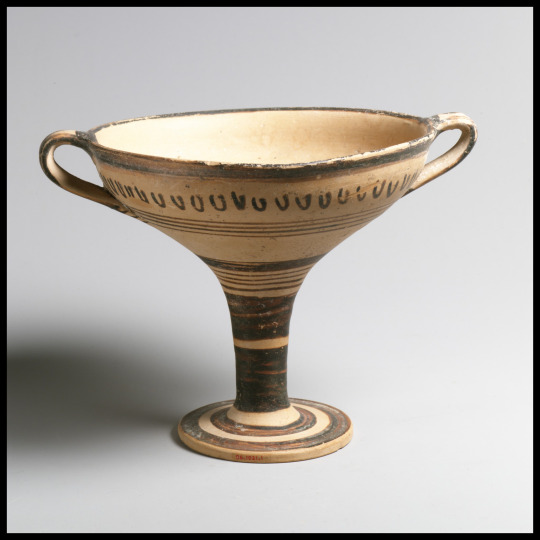
Wine in Korithia predates both the Korithians and the Arkodians, and had already been developed by several cultures on the islands including the Awaxi mentioned earlier. Wine is one of the most commonly consumed beverages, only surpassed by water, and slightly more common than psamarla, a Korithian version of unfiltered beer. Wine has many social, religious, and economic uses and is essential in the trade of the plantbrew, making up the base of many kinds of potion. There are many varieties of wine, with some being viewed as better or worse than others. Red wine is typically preferred for later in the day as it is believed that it helps to induce sleep while white wine is preferred for the morning and afternoon. Wine is typically watered down at a ratio of 2 parts water to 1 part wine, this may be either with plain or salted water. Unwatered wine is saved for special occasions and certain religious ceremonies in which intoxication is the goal. Wine may be sweetened with honey, figs, or various fruit juices. Herbs and spices such as black pepper, tisparos, coriander, saffron, thyme, and even cannabis and opium and various magical herbs may be added to change the flavor of the wine and to promote other effects.
Recipe
Pick a wine that you like and put it in a glass or cup. You can water it down if you would like but I didn't because I am not Korithian and this was a special occasion.
I finally got this post done! If you decided to read through this whole thing, thank you! Let me know if you try any of these, most of these amounts are ultimately a matter of taste, you can change things and experiment if you want.
Now we'll see if I get to 300 followers and we'll do this all over again with the food from another part of the Green Sea.
Thank you all again for following me, I've really enjoyed sharing my WIP with y'all!
@patternwelded-quill , @skyderman , @flaneurarbiter , @jclibanwrites , @alnaperera, @rhokisb, @blackblooms , @lord-nichron , @kosmic-kore , @friendlyshaped , @axl-ul , @talesfromtheunknowable , @wylanzahn , @dyrewrites , @foragedbonesblog , @kaylinalexanderbooks , @mk-writes-stuff , @roach-pizza
#fantasy food#writeblr#writing#worldbuilding#fantasy#testamentsofthegreensea#fantasy writing#world building#creative writing#story writing#200 followers#thank you guys so much!#fantasy world
51 notes
·
View notes
Text

𝐵𝑒𝑛𝑒𝑎𝑡ℎ 𝑇ℎ𝑒 𝑆𝑖𝑙𝑣𝑒𝑟 𝑀𝑜𝑜𝑛
— # 1𝑲 𝑴𝑰𝑳𝑬𝑺𝑻𝑶𝑵𝑬 𝑬𝑽𝑬𝑵𝑻 .ᐟ 𝜗𝜚₊˚✩⊹

a note from me to you,, thank you all for being apart of the 1,000+ followers who support my account by reading, liking, and reblogging my works. I am truly grateful for each and every one of you. sending a big virtual kiss to each of you!
I can't believe that a small, silly blog I started out of delusion now has 1,000 followers! brb, shedding a few tears. the messages I've received about how my writings have helped you in various ways bring me so much happiness and I'm grateful that my words can be of help. thank you to all who have engaged with me, and I hope we can have even more interactions in the future (please understand that I can't initiate conversations I’m so sorry).
thank you once more for allowing me to reach 1,000+ followers. I appreciate each and every one of you dearly, and you all hold a special place in my heart. you guys mean so much to me, mwah mwah!

starting off,, I'm planning to celebrate this important milestone by organizing an event. It's going to be a piece of cake! I'll provide a list of dialogue prompts, and all you lovely people have to do is select one and pair it with a jjk character. It's as simple as that! Choose, pick, and ask away. easy, right?
simply select a prompt that interests you, choose a character, and head over to my askbox (feel free to include any extra details with your requests!).
these will posted as little blurbs / drabbles because I find them easier to write while also helping me to get to the rest of your guys’ asks faster!
I will only be taking one request per character, and it will be on a first come, first served basis. If your request isn't completed, it's because someone else has already claimed either the prompt, the character, or both. sorry :(

…𝓅𝓇ℴ𝓂𝓅𝓉 𝓁𝒾𝓈𝓉 .ᐟ
"okay, listen — you're pretty, and i'm cute..." "don't even start with me." "we'd be pretty cute together!"
"you're pretty." "what?" "i said you look shitty." "i haven't slept for like — two days, give me a break."
“apparently I still suck at this gift giving thing.”
“we’re not just friends and you fucking know it”
“you can’t tell but I’m winking at you”
“I can’t get over how a few months ago I wanted to learn your name and now you’re having breakfast with me in my sweater”
“oh my god it’s like watching your parents making out - oh wait no - that’s exactly what this is”
“how much of that did you hear?”
…𝓬𝓱𝓪𝓻𝓪𝓬𝓽𝓮𝓻𝓼 .ᐟ
gojo satoru . geto suguru . nanami kento . toji fushiguro . itadori yuuji . megumi fushiguro . choso kamo . ino takuma

— # 𝑩𝑬𝑵𝑬𝑨𝑻𝑯 𝑻𝑯𝑬 𝑺𝑰𝑳𝑽𝑬𝑹 𝑴𝑶𝑶𝑵!
#𝑩𝑬𝑵𝑬𝑨𝑻𝑯 𝑻𝑯𝑬 𝑺𝑰𝑳𝑽𝑬𝑹 𝑴𝑶𝑶𝑵!#1𝑲 𝑴𝑰𝑳𝑬𝑺𝑻𝑶𝑵𝑬 𝑬𝑽𝑬𝑵𝑻 .ᐟ 𝜗𝜚₊˚✩⊹#𝐾𝑂𝐼𝑆𝐻𝐼𝑅𝑂𝑆 1𝐾 𝑀𝐼𝐿𝐸𝑆𝑇𝑂𝑁𝐸 𝐸𝑉𝐸𝑁𝑇!#˚₊‧꒰ა ☆ ໒꒱ ‧₊˚ 𝒋𝒖𝒋𝒖𝒕𝒔𝒖 𝒌𝒂𝒊𝒔𝒆𝒏#banner cr ( @kgymz )#divider by ( @muruffin )#thank you guys so much!#i love you guys so much#i love you i love you i love you#mwah mwah#jujutsu kaisen#jujutsu kaisen x reader#jjk x reader#yuji itadori#itadori yuji#gojo satoru#satoru gojo#geto suguru#suguru geto#toji fushiguro#fushiguro toji#nanami kento#kento nanami#ino takuma#takuma ino#choso kamo#kamo choso
21 notes
·
View notes
Text
1K! - Kids over Kids

One thousand followers! Hello! My name is Jo, internet calls me Semi, and I recently reached 1 thousand followers on my silly little Simblr! I’m very happy guys ☺️ Whether you’re following for my stories, my defaults or my silliness, I wanted to share something with you, so here is the first part: kids defaults.

cubodyapron replaced with @rented-space‘s Dad's Old Sweater. Six recolors, all enabled for both genders. Everyday and Outwear. Kitchen & Bath is required.
Download cubodyapron (SFS - Box)
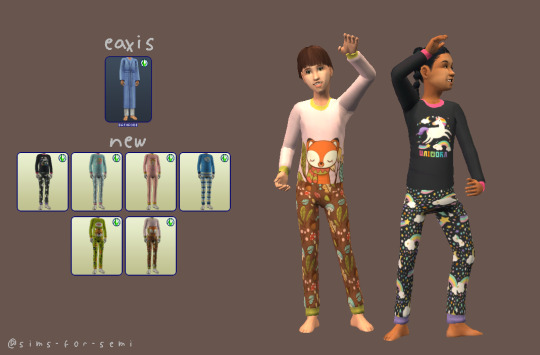
cubodybathrobe replaced with @keoni-chan‘s conversion of Nighty Night PJ’s. Six recolors, all enabled for both genders. PJs only. Kitchen & Bath is required.
Download cubodybathrobe (SFS - Box)
All the credits to the creators 🥰 you make simblr a lovely place.
87 notes
·
View notes
Text
||
While I work on my drafts, I wish to dedicate a special Thank you for a few people who have managed to keep my muse for LB alive.
@drinkthepain, @jynxd, @shimmerbeasts, @restrainedhungr, @veiled-lady & @piltover-sharpshooter
Honestly, if it wasn't for you guys, I would've probably dropped this blog or set it into an infinite hiatus. I owe you all so much!
#there is another behind my own mask (ooc)#drinkthepain#jynxd#shimmerbeasts#restrainedhungr#veiled lady#piltover sharpshooter#thank you guys so much!
10 notes
·
View notes
Text
I HIT 400 FOLLOWERS TODAY!!!🖤


28 notes
·
View notes
Text
yippee thank you for 500, i really appreciate it 🙇♀️

#📰 - latest developments#thank you guys so much!#we actually reached 500 on my birthday but i totally forgot about it!!#i’ll think of an event soon i hope!
5 notes
·
View notes
Text
So uhhh this happened somehow without me noticing


Umm are yall okay? Are yall good? I even cleaned it out to make sure none of them were bots too...it made the number go down by like 5 but still 400?!?! Asdftyh thank youu?? My brain is still computing three digit numbers let alone 100 followers away from 500???
Umm but yeah thanks so much! It means so much that you guys enjoy my writings, ramblings, and sometimes drawings lol
Thank you guys!

#ri rambles#well this snuck up on me#i was just udpating my drafts hnng#thank you guys so much!#i never imagined having this many followers#ever lol
23 notes
·
View notes
Text

Thank you to everyone who got me to 1000 likes!
Thanks guys!

7 notes
·
View notes
Text

3000 posts!
10 notes
·
View notes
Text
"Zis is much better zen last years, don't you zink bee-gor?"
Voting on the poll below would really help me out :)

Looks like Bot-O-Ween 2 wins! Which makes this day 1+2, thus giving me time to figure out execution :sweats:
#transformers#transformers animated#tfa#personal art#tfa blitzwing#maccadam#tfa blitzbee#blitzbee#blitzwing#tfa bumblebee#tf bumblebee#bot o ween#normally i do goretober but october really snuck up on me this year#it did it again#i also have an art tablet now that I'm getting used to#that's why this looks so weird#thank you guys so much!
6 notes
·
View notes
Text
As Promised! A Recipe for Kipsha (Sort of)
Hello everyone! A few days ago I said that, as a way to celebrate reaching 100 followers that I would make one of the dishes from the setting of my WIP.
And I did that! Kind of. You see it turns out that Sainsbury's or at least Google, lied to me, and so I was unable to find barely which was a necessary component of this recipe. Even worse when I returned home I found that the only wheat flour that I had was self-rising.
And so, I did not make Kipsha (recipe here) which is eaten in the western and central parts of Kishetal, rather I made Kipisa which is eaten on eastern border of Kishetal and Makur in cities like Kutar and Nabi (shown below).
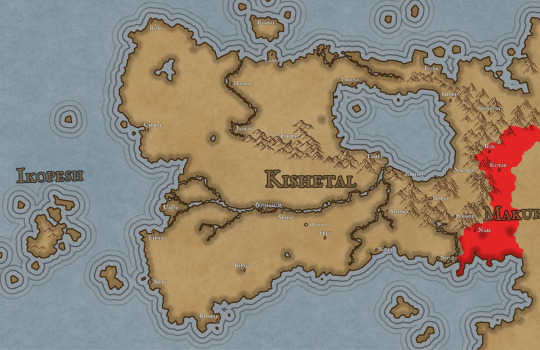
The primary difference between Kipsha and Kipisa is the grain used. Kipisa is made with rye while Kipsha is made with barley. In addition, Kipisa is often served with butter. Butter as a culinary ingredient is almost entirely limited to the eastern plains, where it preferred to or eaten alongside olive oil. Saramuk Ukishiya, meaning "Butter Eater" (Saramuk coming from the Lakuri word for butter, Shayram) is a common derrogatory term used to refer to those people living in the region shown above.
The recipe is below the cut!
Kipisa
Kipsha or Kipisa or Kipcha is a kind of cake or biscuit commonly eaten by the wealthy and poor alike. It can vary wildly from soft and spongy to harder and more cracker like.
It is a popular form of street food and can be served as savory or sweet. In savory applications honey is typically forgone and olive oil may be replaced with various varieties of animal fat. All varieties contain some amount of barley or more rarely, rye, however examples meant for nobility may contain up to 70 or even 90%.
The name Kipsha is a reference to the sesame and/or poppy seeds used in and sprinkled over the top. Kip being the Kishic word for seed or grain. Though it may also refer to an infant, thus part of the cake's association with fertility.
This recipe is for Sweet Kipisa, as it is enjoyed in the city of Kutar. A similar varient is eaten just across the mountains in Labisa, though here they make use of barley rather rye. It is this barley variety, Kipsha, which is my MC, Narul's favorite dish.
This particular variety of Kipsia is cracker-like, with a slightly chewy interior.
Ingredients
Note: For those ingredients which are not available on earth, approximate substitutes are provided.

The Cakes
(Note that Kishetal has no distinct set of measurements nor are recipes recorded. Recipes are typically passed down orally and differ greatly between regions and even families. Adjust ingredients to one's own liking)
1 ¾ cups Rye Flour
1 ¼ Unbleached Wheat Flour
½ cup Water
1 Tbsp Olive Oil or Untoasted Sesame Oil
2 Tbsp Sweet White Wine (Riesling or Muscat are suggested)
3 Tbsp Kafa (This Kishic yogurt drink can be substituted with equal parts plain greek yogurt and whole milk)
2 Tbsp Honey
1 Tbsp Red Wine Vinegar
2 ½ Tsp Untoasted White Sesame Seeds
½ Tsp Sinrian Cinnamon (Substitute Cassia Cinnamon)
¼ Tsp Ground Black Pepper
Toppings
1. This are meant to reflect Narul’s Preferred Toppings, though with the addition of more typically eastern additions
1-2 Dried figs chopped (Fresh figs may be substituted)
3 Tbsp Honey, warmed
2 Tbsp Regula Juice (Substitute 1:1 parts orange and lemon juice)
Ground black pepper to taste
Sesame Seeds to taste
Chibalan Salt to taste (Substitute: Flake Salt)
Torn mint leaves
Goat Butter, melted (Cow or sheep is also acceptable)
2. Other Toppings
Unsalted soft cheese such as ricotta
Yogurt
Dates
Crushed nuts (typically walnuts or pistachios)
Chopped Cherries or other fruits
Preparation
1. Combine all dry ingredients in a large bowl.
2. In a different bowl combine all liquid ingredients and whisk thoroughly.
3. Combine wet and dry ingredients, knead using your hands to form a firm ball, add water and flour as needed to achieve this.

4. Cover the dough with a damp towel and allow it to rest at room temperature for a minimum of 1 hour and a maximum of 4.
5. Preheat oven to 400 F or 200 C (fan 195 C).
6. Liberally dust a counter or large cutting board with rye flour. Dust a rolling pin or similar instrument with flour.
7. Place the rested dough onto the floured surface and roll out to approximately 1/4 inch
8. Using a biscuit cutter or knife, cut dough into cakes, these can be any number of shapes, delicately score the surface.

9. Place cakes on a covered cookie sheet making sure that they do not touch.
10. Bake for 10-15 minutes until golden or lightly browned.

11. Remove and immeditately apply melted butter, honey, and regalu juice to surface. Allow to sit and cool for at least 5 minutes (Kipisa is not eaten hot. The more time is allowed for the absorption of the toppings, the better)
12. Once cool, add additional toppings. It is not unusual at this point to add additional butter and honey, nor is it unheard to dip the cake in the regalu juice and butter while eating it.

13. Enjoy!

I probably should have a taglist but I don't know who all would be on it, whoops. So I'm just tagging my followers that liked the original post
@patternwelded-quill , @skyderman , @flaneurarbiter , @jclibanwrites , @alnaperera, @rhokisb, @blackblooms , @lord-nichron , @kosmic-kore , @friendlyshaped , @axl-ul , @talesfromtheunknowable , @wylanzahn , @dyrewrites , @foragedbonesblog
#writeblr#writing#fantasy#worldbuilding#queer fantasy#fantasy food#fantasy writing#fantasy world#world building#testamentsofthegreensea#narul#WIP#100 followers#thank you guys so much!#Let me know if y'all want to be tagged in this sort of thing in the future
27 notes
·
View notes
Text
Milestone?
I was scrolling through my (interacting feed? the lightning bolt symbol thing that shows all notes I've received and such), when I came across a notification from Tumblr saying that my blog hit 2,500 likes back in April 30th this year!
I didn't even know they had those types of notifications, but that's exciting!! I think!! (Maybe it's really easy to hit this many likes, I don't know x_x. I'm a small blog though so I think it's safe to be a little proud of this!)
Anyway, when I clicked on that notification, it automatically made a post with this picture down below on it, so that's convenient haha.

It's great to see how much hatred there is for juvia and her disgusting ship :)!
But more importantly, so many thank yous to everyone who has been supporting me, whether you're one of my lovely followers or just a really cool someone cruising on through my blog! I really appreciate every like, comment, reblog, and ask! I hope to create anti gr///via content for a long time for you guys!
#thank you guys so much!#yall are the best#2500 likes#tumblr milestone#anti juvia#anti gruvia#anti juvia lockser#anti juvia loxar#anti gray x juvia#anti gray fullbuster x juvia lockser#fairy tail#fairytail#gruviugh#gruvia can burn#gruvia sucks
19 notes
·
View notes
Text
I've been waiting.
nemA 𖤐

#the coveted 666#yasssss#thank you guys so much!#ghost#ghost creator#ghost fan fics#ghost fanfiction#ghost smut writer#sister of sin
15 notes
·
View notes
Text

🥺😭😭❤️❤️❤️❤️ WHAT?! THANK YOU ALL FOR FOLLOWING! I’m totally not crying or anything
4 notes
·
View notes
Text

Uh. Um uh a, u huh whu wa????
I never thought I’d make it this far tbh.
I wanna do something special for all my awesome followers, so I’m gonna do a six fanart thingy,

(this one)
but with a tWiSt~
You give me not one, but TWO characters and imma fuse them :)
(Note that this is only for my followers)
27 notes
·
View notes
Text
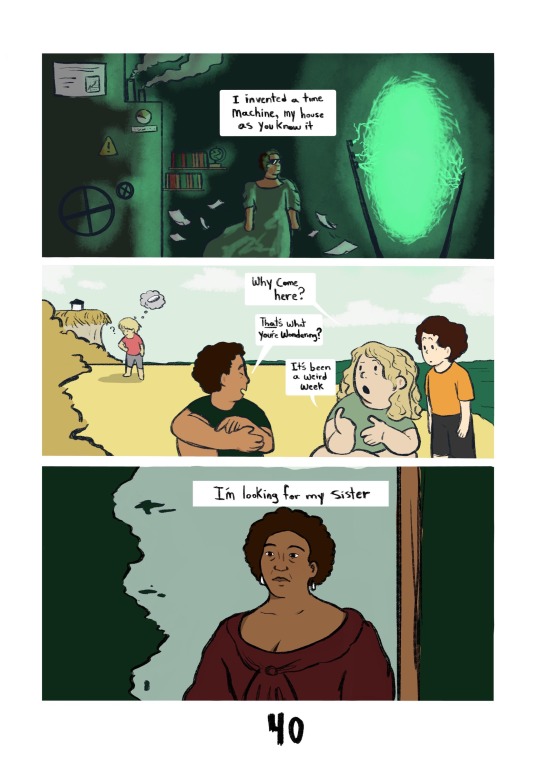
Off Course 40
#off course#g/t#gt#comics#made it to 400 followers!#thank you guys so much!#any requests to celebrate?
15 notes
·
View notes